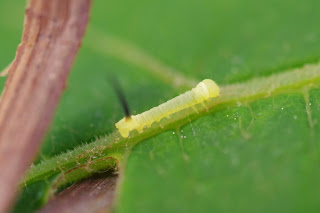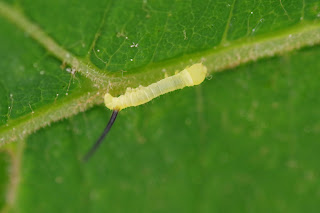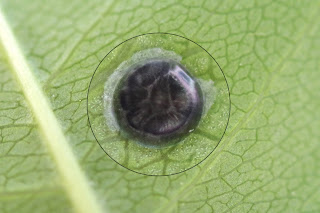Having said all of that, sorry, Mom, you're not going to enjoy today's blog very much.
I am thinking about caterpillars because I saw a lot of them today. Starting with the Backyard Bug of the Day:
I was working on a project in my backyard today and found this caterpillar crawling on it. I don't know where it came from, just suddenly it was there.
Based on that spike on its back end I am guessing that it is a sphinx moth caterpillar of some kind, though I think there are some species of different families (not sure if that is the right taxonomic classification) that have them. I am not even going to bother to look this up; this caterpillar was less than a quarter inch long, so it was an early instar, and it doesn't have much in the way of identifying features at the moment other than that extraordinary tail spike. There is no way I would be able to find it in my caterpillar guide.
From this angle you can't even see the spike...
About that spike–it's not a stinger. From what I have read in the past, no one knows what it is for. It looks like a massive encumbrance, though, like it would constantly be getting caught on things. One cannot help but wonder how self-aware caterpillars are...
Sorry for all the bad photos; I was so focused on, well, trying to get a picture in focus of this constantly moving creature that I forgot what setting my camera was on when the caterpillar moved into the bright sunlight.
I moved it onto a grape leaf, figuring that since I found it on a piece of grape vine I was using in my project, that might be its host plant. Perhaps ironically, after what I said above, when I went back to look at it only minutes later it was gone.
Like I said, I saw quite a few caterpillars today:
They often have ants attend to them, as some other similar species do.
Tiny looper on the mail bin.
Forest tent caterpillar
I found two white marked tussock moth caterpillars today:
This one was small, but has acquired the characteristic appearance and accoutrements of the species, looking like it was made by a seven year old out of leftover craft materials.
But do you remember the one I posted yesterday, that was a very early instar and still not quite looking like a white marked tussock moth caterpillar yet?
It has molted since then, and is looking more like the one above. Its head is not bright orange, but I think that is probably because it takes a while for the face color to develop in some caterpillars when they molt. You can see the skin that it shed when it molted. And I actually went to find this one after I took the picture above, knowing where to look because it was in the same place as yesterday.
To give you a sense of the size difference between the two, here are each of them with my finger for scale:
There was one species of caterpillar that I did not photograph, but I saw at least a dozen of today: gypsy moth caterpillars. The one that I least want to see, ever.
Other Bugs:
A former caterpillar
Assassin bug. Maybe this should be in Arachnid Appreciation, because I think that is a spider the assassin bug is appreciating for lunch.
This vine had quite a gathering of tiny nymphs:
I am pretty sure there are two different species here...
Those don't look like they could be different instars of the same species, do they?
Lady beetle on milkweed buds, which don't look like they are planning to bloom anytime soon.
Scorpionfly female
This little Hemiptera nymph is clearly predatory, but it does not look like any of the assassin bugs that I know. Not that assassin bugs are the only predatory Hemiptera.
I don't know what this is, but my guess would be an insect egg.
Or maybe an egg mass? That looks like there could be several things in there. It was on a leaf with a lace bug, and knowing what lace bug nymphs look like, and how small they are, it is conceivable that there are several in there... Okay, I looked it up, and this is not a lacebug egg. So... I don't know what it is.
Bee. The only bee I saw today. It concerns me how few bees I have been seeing the last couple of months.
Arachnid Appreciation:
.
.
.
.
.
.
.
.
.
.
.
.





























No comments:
Post a Comment